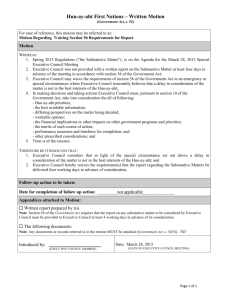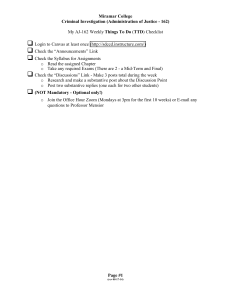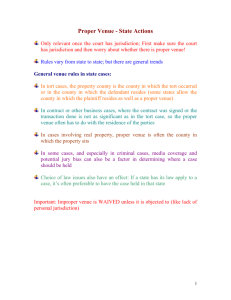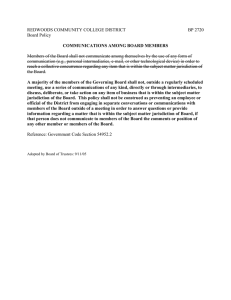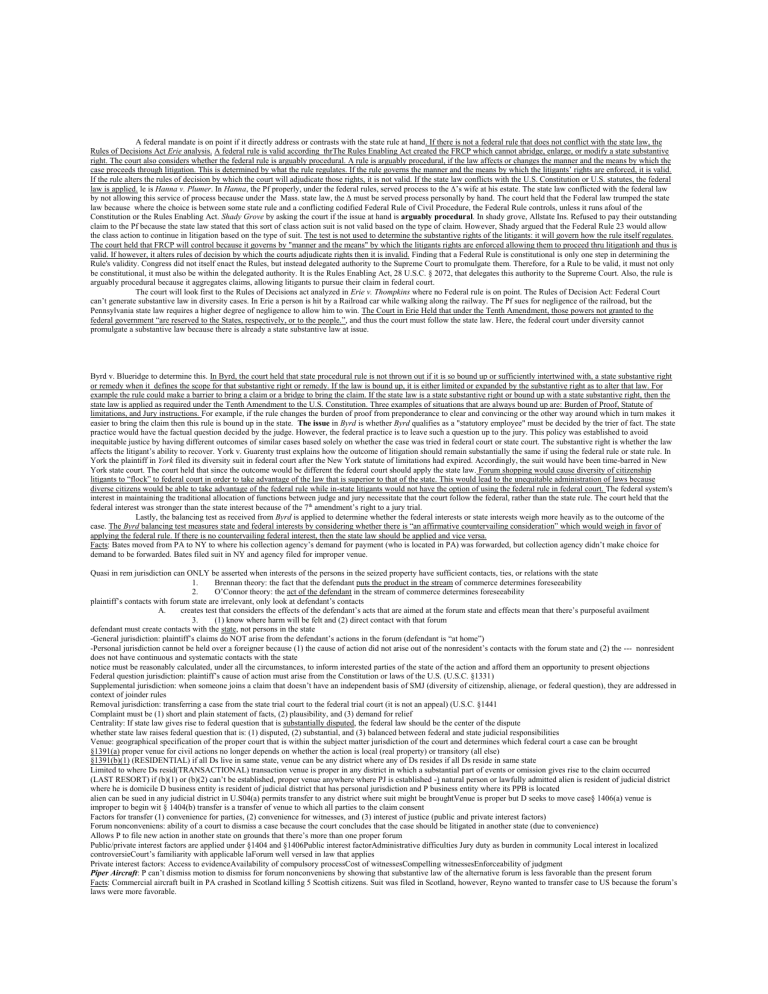
A federal mandate is on point if it directly address or contrasts with the state rule at hand. If there is not a federal rule that does not conflict with the state law, the Rules of Decisions Act Erie analysis. A federal rule is valid according thrThe Rules Enabling Act created the FRCP which cannot abridge, enlarge, or modify a state substantive right. The court also considers whether the federal rule is arguably procedural. A rule is arguably procedural, if the law affects or changes the manner and the means by which the case proceeds through litigation. This is determined by what the rule regulates. If the rule governs the manner and the means by which the litigants’ rights are enforced, it is valid. If the rule alters the rules of decision by which the court will adjudicate those rights, it is not valid. If the state law conflicts with the U.S. Constitution or U.S. statutes, the federal law is applied. le is Hanna v. Plumer. In Hanna, the Pf properly, under the federal rules, served process to the ∆’s wife at his estate. The state law conflicted with the federal law by not allowing this service of process because under the Mass. state law, the ∆ must be served process personally by hand. The court held that the Federal law trumped the state law because where the choice is between some state rule and a conflicting codified Federal Rule of Civil Procedure, the Federal Rule controls, unless it runs afoul of the Constitution or the Rules Enabling Act. Shady Grove by asking the court if the issue at hand is arguably procedural. In shady grove, Allstate Ins. Refused to pay their outstanding claim to the Pf because the state law stated that this sort of class action suit is not valid based on the type of claim. However, Shady argued that the Federal Rule 23 would allow the class action to continue in litigation based on the type of suit. The test is not used to determine the substantive rights of the litigants: it will govern how the rule itself regulates. The court held that FRCP will control because it governs by "manner and the means" by which the litigants rights are enforced allowing them to proceed thru litigationh and thus is valid. If however, it alters rules of decision by which the courts adjudicate rights then it is invalid. Finding that a Federal Rule is constitutional is only one step in determining the Rule's validity. Congress did not itself enact the Rules, but instead delegated authority to the Supreme Court to promulgate them. Therefore, for a Rule to be valid, it must not only be constitutional, it must also be within the delegated authority. It is the Rules Enabling Act, 28 U.S.C. § 2072, that delegates this authority to the Supreme Court. Also, the rule is arguably procedural because it aggregates claims, allowing litigants to pursue their claim in federal court. The court will look first to the Rules of Decisions act analyzed in Erie v. Thompkins where no Federal rule is on point. The Rules of Decision Act: Federal Court can’t generate substantive law in diversity cases. In Erie a person is hit by a Railroad car while walking along the railway. The Pf sues for negligence of the railroad, but the Pennsylvania state law requires a higher degree of negligence to allow him to win. The Court in Erie Held that under the Tenth Amendment, those powers not granted to the federal government “are reserved to the States, respectively, or to the people.”, and thus the court must follow the state law. Here, the federal court under diversity cannot promulgate a substantive law because there is already a state substantive law at issue. Byrd v. Blueridge to determine this. In Byrd, the court held that state procedural rule is not thrown out if it is so bound up or sufficiently intertwined with, a state substantive right or remedy when it defines the scope for that substantive right or remedy. If the law is bound up, it is either limited or expanded by the substantive right as to alter that law. For example the rule could make a barrier to bring a claim or a bridge to bring the claim. If the state law is a state substantive right or bound up with a state substantive right, then the state law is applied as required under the Tenth Amendment to the U.S. Constitution. Three examples of situations that are always bound up are: Burden of Proof, Statute of limitations, and Jury instructions. For example, if the rule changes the burden of proof from preponderance to clear and convincing or the other way around which in turn makes it easier to bring the claim then this rule is bound up in the state. The issue in Byrd is whether Byrd qualifies as a "statutory employee" must be decided by the trier of fact. The state practice would have the factual question decided by the judge. However, the federal practice is to leave such a question up to the jury. This policy was established to avoid inequitable justice by having different outcomes of similar cases based solely on whether the case was tried in federal court or state court. The substantive right is whether the law affects the litigant’s ability to recover. York v. Guarenty trust explains how the outcome of litigation should remain substantially the same if using the federal rule or state rule. In York the plaintiff in York filed its diversity suit in federal court after the New York statute of limitations had expired. Accordingly, the suit would have been time-barred in New York state court. The court held that since the outcome would be different the federal court should apply the state law. Forum shopping would cause diversity of citizenship litigants to “flock” to federal court in order to take advantage of the law that is superior to that of the state. This would lead to the unequitable administration of laws because diverse citizens would be able to take advantage of the federal rule while in-state litigants would not have the option of using the federal rule in federal court. The federal system's interest in maintaining the traditional allocation of functions between judge and jury necessitate that the court follow the federal, rather than the state rule. The court held that the federal interest was stronger than the state interest because of the 7th amendment’s right to a jury trial. Lastly, the balancing test as received from Byrd is applied to determine whether the federal interests or state interests weigh more heavily as to the outcome of the case. The Byrd balancing test measures state and federal interests by considering whether there is “an affirmative countervailing consideration” which would weigh in favor of applying the federal rule. If there is no countervailing federal interest, then the state law should be applied and vice versa. Facts: Bates moved from PA to NY to where his collection agency’s demand for payment (who is located in PA) was forwarded, but collection agency didn’t make choice for demand to be forwarded. Bates filed suit in NY and agency filed for improper venue. Quasi in rem jurisdiction can ONLY be asserted when interests of the persons in the seized property have sufficient contacts, ties, or relations with the state 1. Brennan theory: the fact that the defendant puts the product in the stream of commerce determines foreseeability 2. O’Connor theory: the act of the defendant in the stream of commerce determines foreseeability plaintiff’s contacts with forum state are irrelevant, only look at defendant’s contacts A. creates test that considers the effects of the defendant’s acts that are aimed at the forum state and effects mean that there’s purposeful availment 3. (1) know where harm will be felt and (2) direct contact with that forum defendant must create contacts with the state, not persons in the state -General jurisdiction: plaintiff’s claims do NOT arise from the defendant’s actions in the forum (defendant is “at home”) -Personal jurisdiction cannot be held over a foreigner because (1) the cause of action did not arise out of the nonresident’s contacts with the forum state and (2) the --- nonresident does not have continuous and systematic contacts with the state notice must be reasonably calculated, under all the circumstances, to inform interested parties of the state of the action and afford them an opportunity to present objections Federal question jurisdiction: plaintiff’s cause of action must arise from the Constitution or laws of the U.S. (U.S.C. §1331) Supplemental jurisdiction: when someone joins a claim that doesn’t have an independent basis of SMJ (diversity of citizenship, alienage, or federal question), they are addressed in context of joinder rules Removal jurisdiction: transferring a case from the state trial court to the federal trial court (it is not an appeal) (U.S.C. §1441 Complaint must be (1) short and plain statement of facts, (2) plausibility, and (3) demand for relief Centrality: If state law gives rise to federal question that is substantially disputed, the federal law should be the center of the dispute whether state law raises federal question that is: (1) disputed, (2) substantial, and (3) balanced between federal and state judicial responsibilities Venue: geographical specification of the proper court that is within the subject matter jurisdiction of the court and determines which federal court a case can be brought §1391(a) proper venue for civil actions no longer depends on whether the action is local (real property) or transitory (all else) §1391(b)(1) (RESIDENTIAL) if all Ds live in same state, venue can be any district where any of Ds resides if all Ds reside in same state Limited to where Ds resid(TRANSACTIONAL) transaction venue is proper in any district in which a substantial part of events or omission gives rise to the claim occurred (LAST RESORT) if (b)(1) or (b)(2) can’t be established, proper venue anywhere where PJ is established -) natural person or lawfully admitted alien is resident of judicial district where he is domicile D business entity is resident of judicial district that has personal jurisdiction and P business entity where its PPB is located alien can be sued in any judicial district in U.S04(a) permits transfer to any district where suit might be broughtVenue is proper but D seeks to move case§ 1406(a) venue is improper to begin wit § 1404(b) transfer is a transfer of venue to which all parties to the claim consent Factors for transfer (1) convenience for parties, (2) convenience for witnesses, and (3) interest of justice (public and private interest factors) Forum nonconveniens: ability of a court to dismiss a case because the court concludes that the case should be litigated in another state (due to convenience) Allows P to file new action in another state on grounds that there’s more than one proper forum Public/private interest factors are applied under §1404 and §1406Public interest factorAdministrative difficulties Jury duty as burden in community Local interest in localized controversieCourt’s familiarity with applicable laForum well versed in law that applies Private interest factors: Access to evidenceAvailability of compulsory processCost of witnessesCompelling witnessesEnforceability of judgment Piper Aircraft: P can’t dismiss motion to dismiss for forum nonconveniens by showing that substantive law of the alternative forum is less favorable than the present forum Facts: Commercial aircraft built in PA crashed in Scotland killing 5 Scottish citizens. Suit was filed in Scotland, however, Reyno wanted to transfer case to US because the forum’s laws were more favorable. Rule 12 PrinciplesPrinciple 1: Rule 12(b)(2-5) must be put in first defensive response (motion or answer)If they are not put in first defensive response, they are waived Principle 2: Rule 12(b)(6-7) may be raised as late as “at trial” which means any time before entry of judgment by trial court Defenses don’t have to be put in D’s first response; waived only if they’re not raised sometime before judgmentPrinciple 3: 12(b)(1) may be raised any time Limited SMJ of federal courts is a matter of governmental structure Collateral attack: D ignores the hearing until a default judgment is entered, then D would argue the state did not have personal jurisdiction Problems: (1) P might try to enforce judgment anywhere client has property or (2) collateral attack only allows D to raise issues based on jurisdiction, not merit Direct attack: D appears in the state to contest the state’s assertion of personal jurisdiction Problem: D will have to find an attorney in the state to make an appearance Pleading: document setting forth factual and legal contentions (Rule 8.9) Pleading types: (1) complaint, (2) answer, (3) counterclaim, (4) crossclaim, (5) reply, and (6) third party complaint/answer Complaint (Rule 8)hree parts of a complaint (1) short plaint statement of grounds for jurisdiction, (2) short plaint statement of claim showing entitlement to relief, and (3) demand for relief soughtDiogaurdi: if the case is possible, cases can move to the discovery phase Twombly: established the plausibility standard that requires P to show some type of “plus factor” for a pleading to be to be raised above the speculative level Court should ignore conclusions of law and focus on alleged facts Facts support a plausible claim, not just a possible claim-To determine plausibility, judges use their own experience and common sense Complaints alleging fraud, mistake, or special damages must be more detailed Facts: two U.S. citizens sued AT&T alleging violation of the Sherman Act that because of the agreement with another telecomm. co. to not compete. Iqbal: the plausibility standard applies to all cases, not just anti-trust suits Facts: Iqbal was detained in investigation of terrorist attacks and sued claiming racism because he was Muslim. Iqbal’s facts did not display a plausible claim for illegal racism. Parts to a motion: (1) writing, (2) particular grounds for seeking order, and (3) specific relief sought Motions to dismiss that are waived if not addressed in answer: improper PJ, improper venue, insufficient service of process, and insufficient process Motion to Strike (Rule 12(f)) Can strike any statement that is redundant, impertinent, repetitive, or scandalous DISCOVER Duty to disclose certain information without a request from the other party to iNITIAL disclosuresMust identify (1) people with discoverable info that may be used to support the case (2) copies/descriptions of things may be used to support your case, (3) calculation of damages, and (4) insurance DISCOVERY TOOLSDepositions (Rule 30, 31): deponent testifies orally under oath by answering questions by the lawyers of the various partiesCan depose party or nonparty Nonparties must be subpoenaed Interrogatories written questions answered in writing under oatHave 30 days to answer Receive background informationOnly available to parties Production of Documents (Rule 34): get access to certain things 34(a) applies to parties 34(c) applies to nonparties with subpoena Medical Examination (Rule 35): Must get a court order Must show (1) medical condition is in controversy and (2) good cause Only on party or someone in the party’s custody or legal control Requests for Admission (asks to admit or deny any discoverable matter f not denied, it’s admittedOnly available to parties Standard of discoverability 26(b )(1-4)Discoverable material is limited to information that is (1) relevant to the claim or defense and (2) proportional to the needs of the caseDiscoverable material cant be unduly burdensomeThe document cannot be priveliged and all info that is not priviledged aLWAYS DISCOVERABLE mental impressions, conclusions, opinions, and legal theories summary judge- Party moving for summary judgment must show (1) there’s no genuine dispute on a material fact and (2) she is entitled to judgment as an entitlement of law If only dispute of law, court can resolve the issue without trial Common law remedy is compensatory damages (money to make person whole for harm done by D) Equitable remedies are injunction or specific performance Venire: the group from which the final selection of the jury will be chosen Voir dire: gather information about prospective jurors’ possible knowledge, bias, or opinions about the case or parties A.
